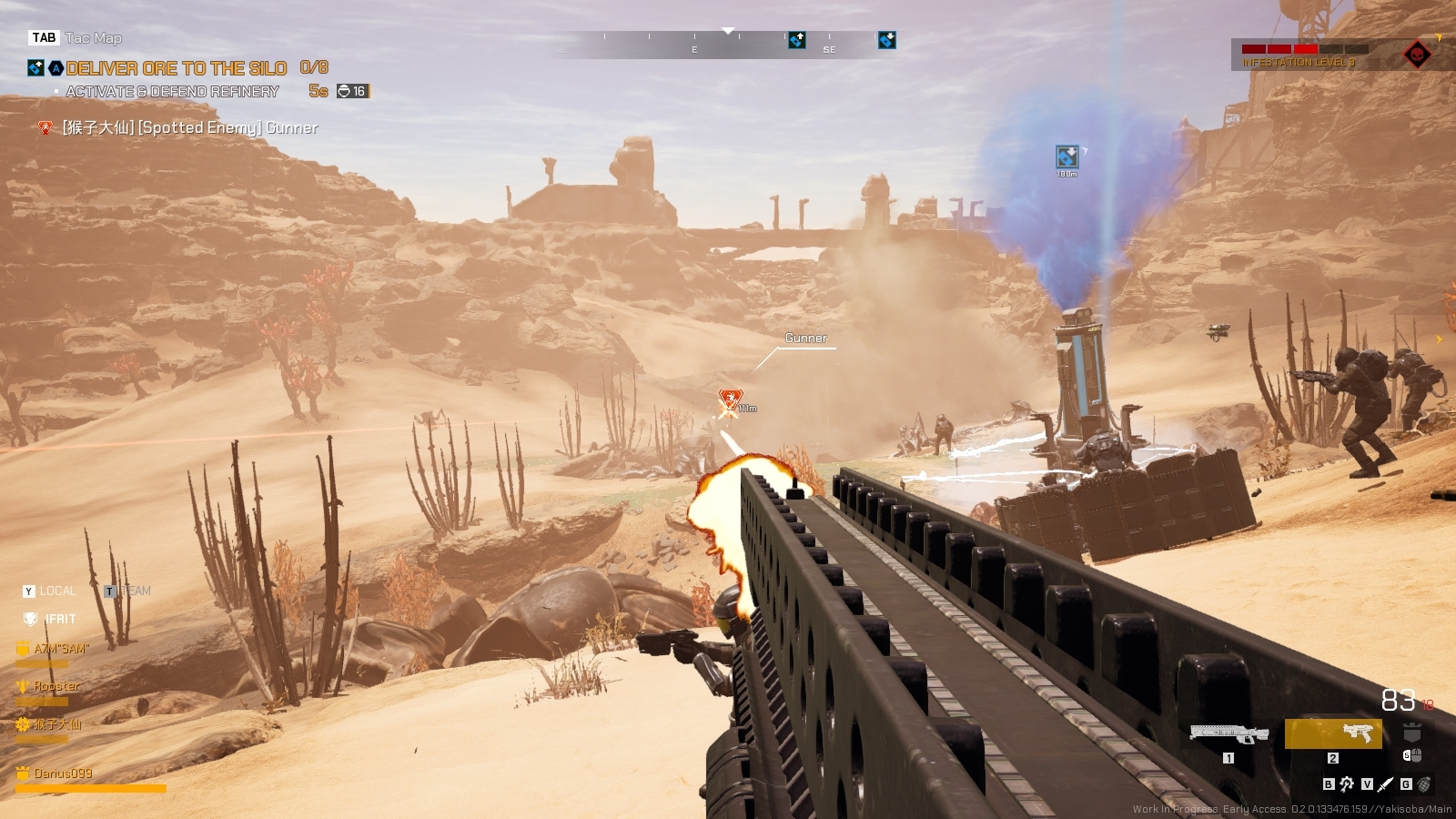Starship Troopers: Extermination is a 16-player co-op FTS/RTS hybrid with lots of promise
The bug battle is out in early access now.

Popping into early access on May 17, Starship Troopers: Extermination is a bit of a unicorn: a 16-player co-op FPS with strategy base building elements from the makers of Squad. Giant bugs who view you as a wandering happy meal with an inconvenient ceramic armor wrapper. As a long-time lover of the strange genre blend of strategy, multiplayer, and FPS—dating all the way back through the Natural Selection games, Empires mod, and co-op fare like Deep Rock Galactic and Payday—I had to see what Extermination was all about. Turns out it's a promising foundation for future fort building and bug gut splattering.
My journey to understanding this wasn't exactly bubble wrapped: Within seconds of my first experience in Extermination, the ground was rumbling and sand and dust were swirling around me. I wasn't entirely sure what I should be doing but it became clear that, whatever it was, I should be doing it somewhere else. Moments later, my screen was flooded with giant bugs and I distinctly heard shouting over voice from my squadmates. I managed only a panicked burst of wild rifle shots before I was completely swarmed. It wasn't exactly an auspicious start, but it wouldn't take long before I was at home as a disposable cog in Extermination's machine.

Building in an age of bugs
Extermination has two mission types to play so far, though there are more on the roadmap for the future. AAS is the shorter mission, seeing you run down a few objectives across the map—collecting resources, hunting down patrols, etc—before building a quick base and defending it while the bugs assault for a set amount of time. My rounds of it took about 20-30 minutes if I played the full thing, but even on the highest difficulty, the smaller objectives we had to complete before building our base felt like a waste of time.
With the other mode, ARC, you'll be building a base from the start. You'll skitter all over the map to run missions similar to the ones in AAS, but you'll be repeating them a lot. The resources you gather are spent to construct things before defending your base like in AAS. ARC matches are often way longer—over an hour in a few cases—as we slowly dragged back canisters of resources to afford to get walls and bunkers built. I liked the more strategic feel behind this, since in AAS mode you're given essentially unlimited resources to build with and have to do so in a very compressed time frame. But the lack of diversity in things to build and the arbitrary limits on each type of structure made me feel like there was always an optimal way to do things. Without significant additions to the building and resource gathering, this entire part of the game feels far too shallow, especially in the longer ARC mode where base building is the emphasis.
Stepping up to the base walls to take on the bug hordes with Extermination's weapons exposes some flaws. The recoil and firing patterns are satisfying, but with a limited weapon set and no weapon customization my desire to keep playing with them ran out quickly.
The three classes available—Hunter, Bastion, and Operator—each have a unique ability, and a few choices of accessories and perks. With the Hunter moving faster and packing a jetpack to leap skyward on a short cooldown, they put the mobile in the mobile infantry, but so far only have access to the standard three rifle variations (rifle, carbine, and sharpshooter). The antithesis to the Hunter is the Bastion, who packs extra armor and the ability to deploy into an immobile siege mode that gives them even more damage reduction and a bunch of weapon stability, extremely required for the machine gun they can unlock. Functioning as the support option, the Operator can activate a revival drone that instantly revives anyone around you for a short period, while also being able to carry an additional objective item—though I found this questionably useful. Despite this, the Operator's variety of utility items and access to a grenade launcher made them my favorite to play in the end.

A good horde shooter should avoid making its enemies interchangeable bullet sponges, and Extermination is on the right track for this. While there's only really five different enemies at the moment, their design is promising. The three varieties of melee bugs are the bulk of what you'll deal with as they try to turn your base into a roach motel. They'll force you to keep repairing your walls and deal with them with a whole lot of firepower or be totally overrun. But with Grenadiers and Gunners, you'll need different strategies, either accurate sharpshooting to take them out at a distance, or utilizing squads of Hunter troopers to run out and take down the giant mortar-bugs hiding behind terrain.
Keep up to date with the most important stories and the best deals, as picked by the PC Gamer team.
Extermination has some rough spots: my fps dropped hard when things got really hectic, and I frequently lamented small design decisions—like how the ore gathering had a long cooldown where myself and my fellow troopers would be standing around doing nothing. But even while playing without friends, I was having a good time leaping to the walls to mow down waves of incoming bug.
The primary complaint I have from my time with Extermination is that it needs more features: more buildings, more weapons, more classes, more missions and objectives, and more enemies, and those are all things that show up on the Starship Troopers: Extermination development roadmap. Whether you've got a couple friends or a whole bunch, the future of Extermination is worth watching.

Sarah is a contributor for PC Gamer, formerly of TechRadar Gaming. With five years of experience writing freelance for several publications, she's covered every genre imaginable and probably a few she made up. She has a passion for diversity and the way different genres can be sandboxes for creativity and emergent storytelling, and loves worldbuilding. With thousands of hours in League of Legends, Overwatch, Minecraft, and countless survival, strategy, roguelike, and RPG entries, she still finds time for offline hobbies like tabletop RPGs, wargaming, miniatures painting, and hockey.

